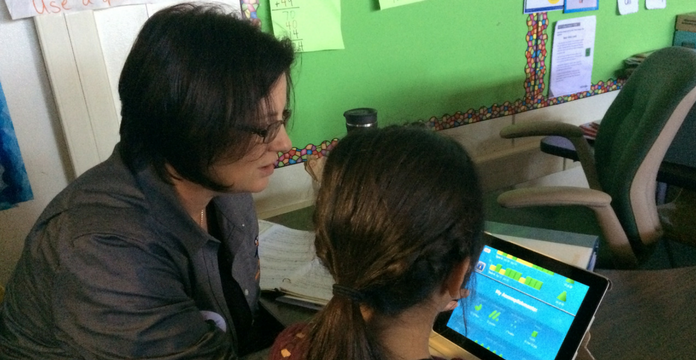
Teaching has always been a part of my life. I taught, my dad taught, and both of my sisters teach. I know firsthand that teachers’ time is filled and frequently overflows into their home life.
When we first set out to redesign the new ST Math, it was important to our team at MIND Research Institute that we optimized the teacher experience. And as a Senior User Experience Researcher, it was important to me that we provided actionable data quickly so that teachers like my dad or sisters have what they need at their fingertips.

The ST Math reporting system is data-rich. The challenge for my team was in identifying critical data and how to make it consumable, digestible, and actionable for teachers.
We’ve spent over 900 user experience research hours in the field, face-to-face with students and educators that have informed the redesign of ST Math. With this redesign, we have set out to place the most actionable data front and center at teachers’ fingertips.
There are no distractions on the screen. Just high-level, actionable, sorted, filterable data. When high-level data indicates a concern, and a teacher wants to investigate further, the supporting data is a click deeper.
When a teacher wants to shift gears from supporting students’ productivity in the program to using ST Math as a small-group, or a whole-group teaching tool, that information is also available one click away from the class page. It is also presented with at-a-glance actionable information up front, and deeper explorations in a progressive discovery from the high-level to the most granular.

We’ve also made it super easy to bounce back to the class page once the teacher has found the content information they were seeking. This progressive discovery is very intentional. We redesigned the program so that someone new to it—which will be everyone when we launch—can quickly and easily access the high-level, easily actionable data:
If you know that much, you know enough to support students’ success and get started implementing with fidelity. All of the additional deep, rich functionality of this robust program is progressively disclosed. It is there for educators when they need it, and it’s tucked out of the way when they don’t.
Placing the highest focus on student productivity was a decision born out of user experience research. Across the country there are varied implementations and variations in the fidelity of these. The thing that kept rising to the top was that teachers need to instantly know which students need support and for which content.

All of the deeper functions of the program are secondary. They’re important! No one would argue that standards correlations or differentiation are not important, but kids can’t work their way through standards and teachers don’t know if students need scaffolding or challenge content if kids aren’t getting productive time to play the games.
This progressive disclosure of information allows for differentiation for teachers too. Those who are less comfortable with technology can spend more time getting familiar with the basics, free from the distractions of the more complex features. Those who are less comfortable with conceptual mathematics can explore what students are working on at their leisure. Those who wish to experience a game before they use it to teach, have quick and easy access to all the content, and to the data about the content, in progressively discoverable ways.
Our UX research and my own experiences show that teachers spend time on the things that maximize student learning. The redesign of ST Math puts that at-a-glance actionable data front-and-center.
In fact, the most actionable data is also at the students’ fingertips, empowering students to be accountable for their own success. And that frees up teacher time to progressively discover the richer features and functions of the program.
Comment